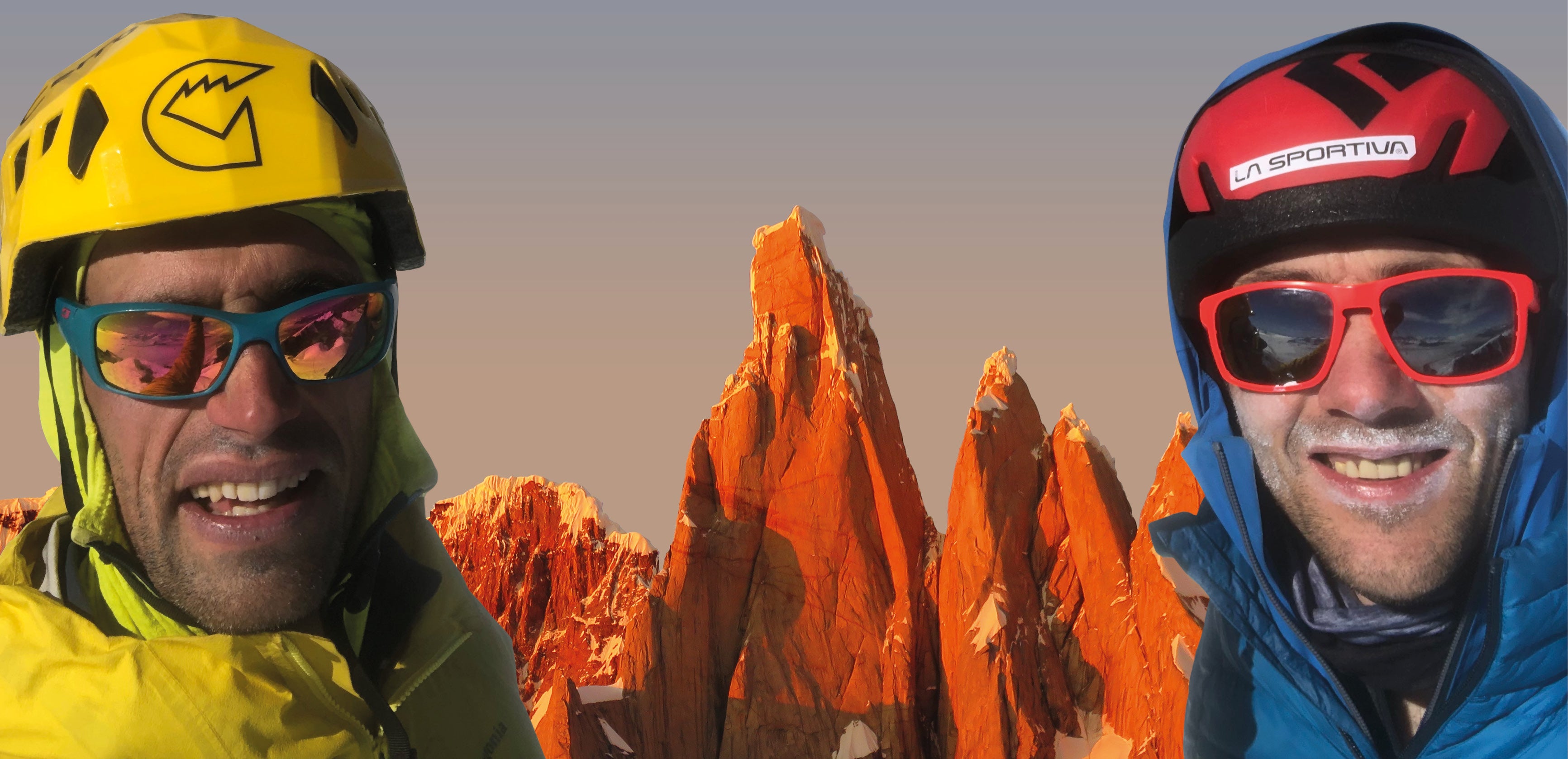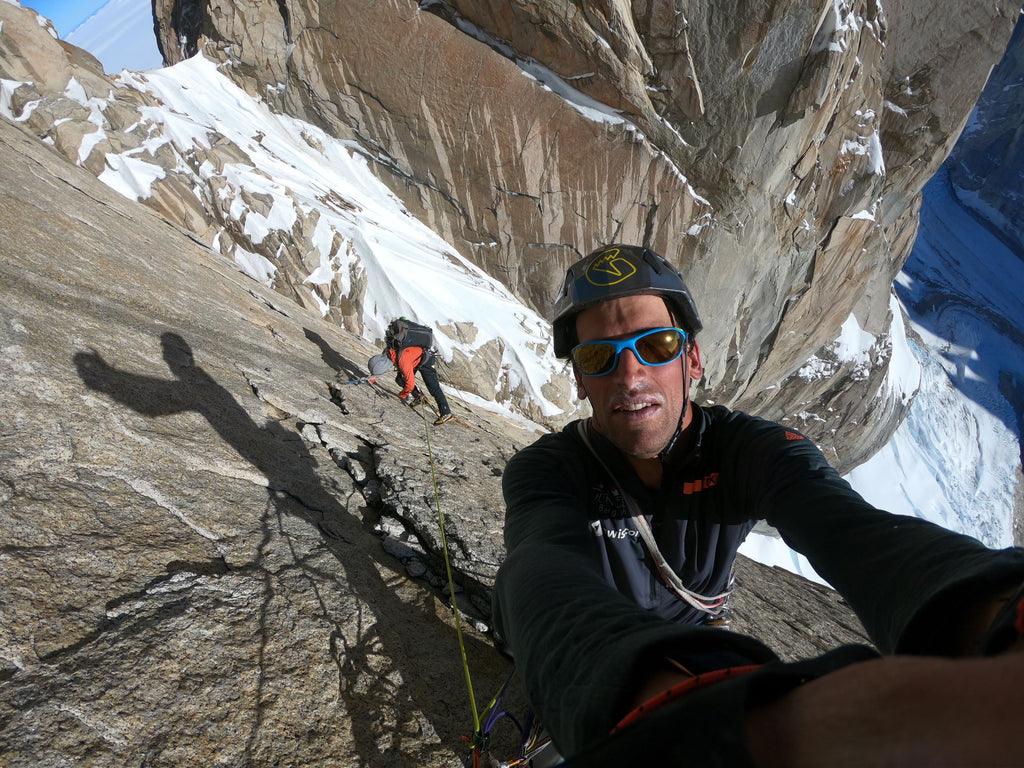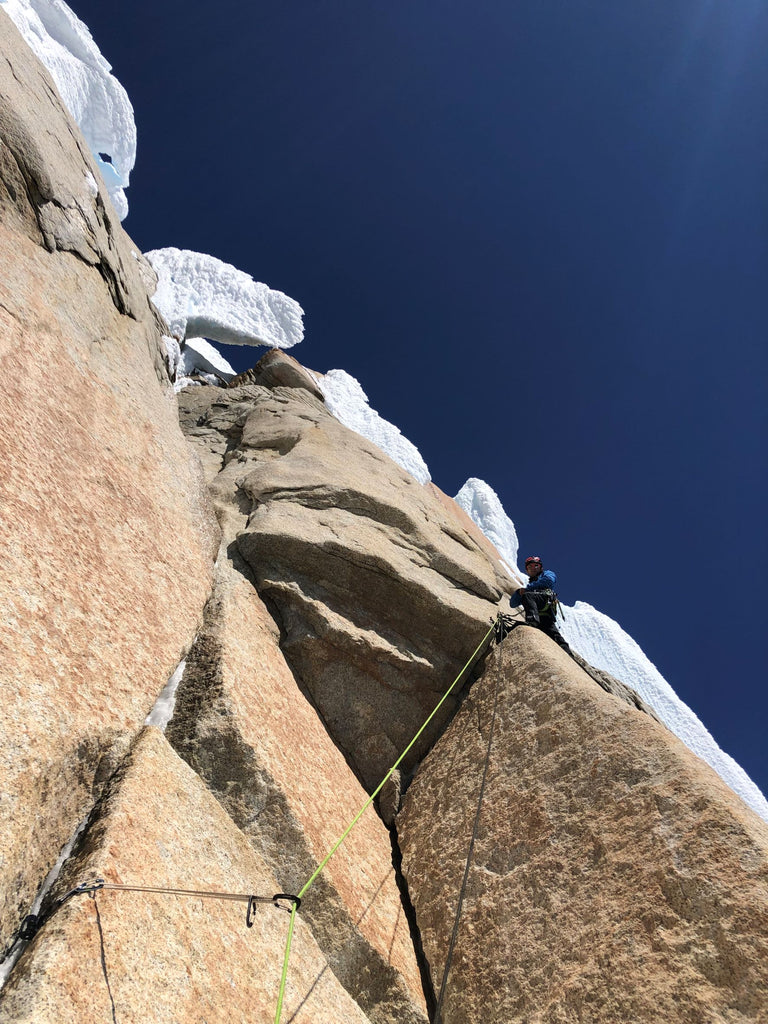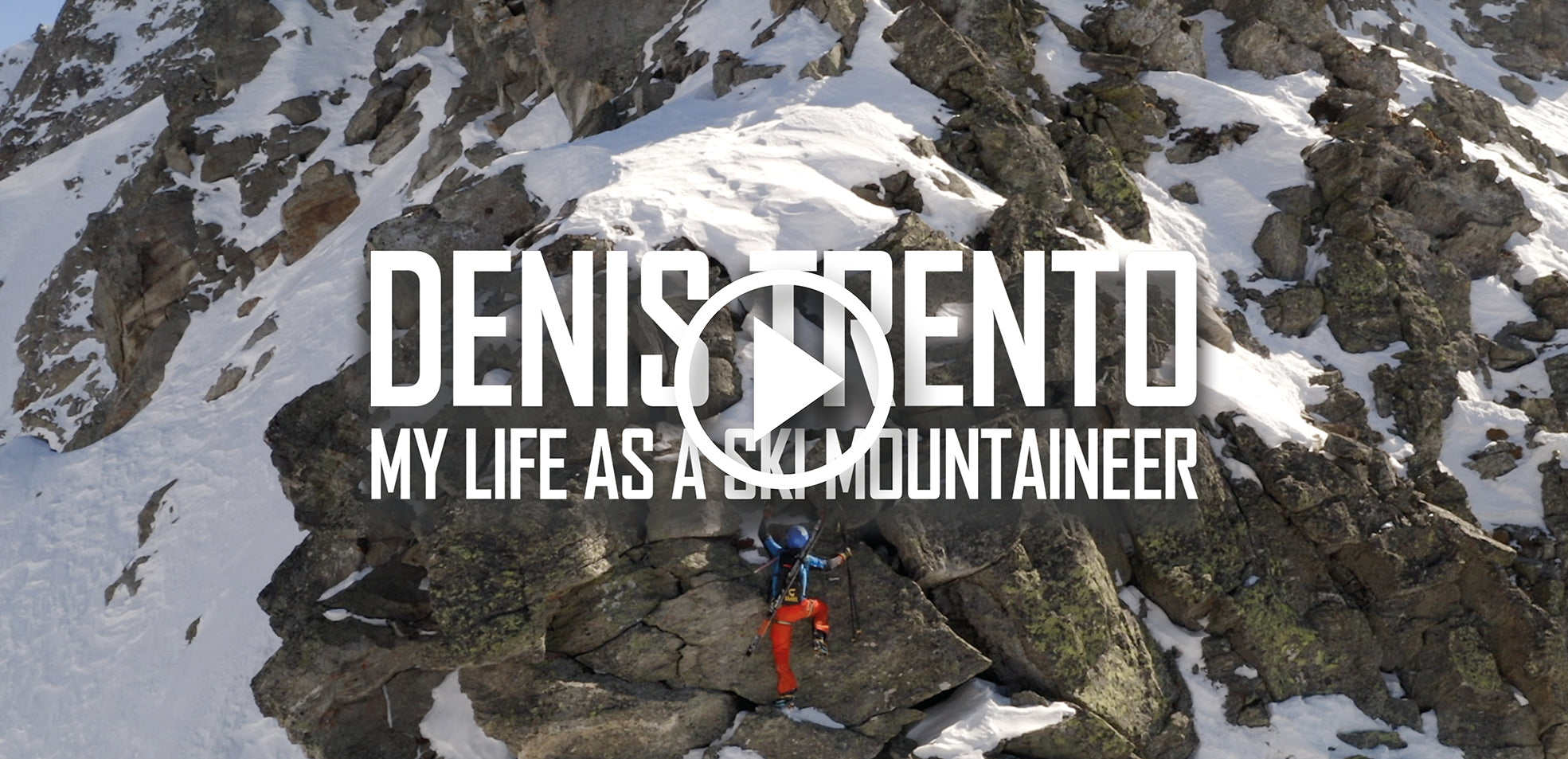
La Norte, triumph and tragedy on Cerro Torre by Tomas Roy Aguilò
Published on 07/04/2022
First attempts on the North Face of Cerro Torre
17 years climbing in El Chalten… I can say that my path was progressive and full of enriching experiences.

In 2013 we climbed with Nicolas Benedetti the Aguja Standhard on the Festerville route, a pleasant north face, with a bit of everything to reach the summit of the little mushroom (which no longer exists). From there we were able to observe the imposing north face of Cerro Torre, our jaws dropped for a moment, and then we said: "That wall can be climbed! Look at the crack systems that can be sensed…".
The truth is that from the Aguja Standhart no crack could be seen... haha, but well our imagination allowed us to dream, and if you can dream it you can achieve it!
Two weeks later we took advantage of a window of good weather, not very long, but the desire to try that granite was very strong. We had no idea what we would find, if it would be possible to climb that wall, if there really were crack systems, weaknesses that would allow us to progress vertically.
This first attempt was more than good, we climbed 6 new pitches on the North Face, micro-scale climbing was possible. But on a macro-scale we should study it better, think of a strategy, we would also need a longer window of good weather. We left that point very happy with what we had completed, especially the learning and the hopes of being able to climb that "impossible" wall that treasures so much history.

In the year 2014 we charged back! This time we changed our strategy, we added a third member to the rope party. A great friend and excellent climber, Jorge Ackermann. We carry more equipment, anticipating any type of terrain. “Excessive” motivation drives us to a try without having good conditions on the wall.
Climbing to the English box is a real "Russian roulette", we flee the mountain like rats ... once in the Noruegos camp, we rearrange equipment and without sleeping, we start the Afanasieff from there... on sight, without sleeping, with half of the Torre in on our backs, we climbed the Afanasieff in 17 hours in an group of 3 … we improvised a lot, clearly we were very strong but the Torre is a mountain, in addition to being complicated, with special conditions.
 Many years pass, many things in between, but the internal flame for that beautiful Mountain is still burning.
Many years pass, many things in between, but the internal flame for that beautiful Mountain is still burning.
In 2019 we return, this time the team made up of Jorge Ackermann and Korra Pesce, the latter a master of ice and mixed climbing. A key Joker for a mountain of this magnitude...

We have much more information, better photos from the Egger Tower, since in previous years we climbed this beautiful tower repeatedly through different routes, having valuable photos of the upper part that we were missing.
Also with the years gained, we managed to better understand the behavior of these icy giants, how they change depending on the weather, temperature, wind, etc... The strategy is much more refined.
The window of good weather is coming to an end, we decided to start the route by an attempt called “Un Sogno Interrotto” (an interrupted dream) which seems of better quality due to a more protected spur than the Americana to the Egger Tower, which starts below the triangular snowfield.

The strategy is non-stop climbing to the top of the first mushroom, along the north face. This time we underestimated the wall, not being fast enough, we reached the altitude of the "Burke-Proctor" traverse at noon, very hot, the wall was quite loaded with frost, which generates a constant fall of ice and water. We have to take shelter in a large dihedral, protected but very uncomfortable. Korra decides to try the next pitch, and after a few steps on aid climbing he falls, breaking his finger. He goes down to the belay and with a hand full of blood we clean it, we bandage it, he puts on the gloves and we think of what comes next. Go down? "No, let's try to continue" were the words of Korra! And so it was, Jorge climbs two new pitches to the start of a vertical ice corridor, and surprisingly Korra, with a broken finger, opens the next ice pitch! We reached the top of the first mushroom where we laid down and slept for a few hours. At dawn the wind increased a lot, our bodies numb from so much wear, more than 40 hours without sleeping uncomfortable hanging on belays, and Korra with his finger that I imagine must have hurt a lot. We decided to go down, take shelter and leave this dream for another time...

In the summer of 2020 we meet again with Korra and Jorge in El Chalten. This season we don't even have a chance to try our route, very hard conditions, a lot of frost and snow on the wall. We climbed the Torre and the Fitz by other routes as if to let out the vice...
2022: the finalization of the new route "La Norte" and the accident
After the strictest period of the Pandemic, we tried to coordinate another attempt to the north, Jorge is in Canada and this year it is difficult to come to Patagonia. Korra does have his winter organized to come from Chamonix to Chalten for two months, or rather until the project is done ...
I met with Korra on January 21st of this year, an immense joy to see my friend back after 2 years, we are very happy. We meet at my house, we chat for a while about our lives, we catch up... and we quickly change the subject... “Did you see the weather? Yes… it comes very good and there are good conditions…”.
We have two days to rest in the town, but there is no time to take gear to the Noruegos camp, since we would be tired for the climb. We decided for the first time to hire porters to lighten our backpacks. Access to the Torre Valley is increasingly difficult, tiring and long, due to the retreat of the glaciers.

On the 24th we started walking, it's time... with light backpacks it takes us about 8 hours to get to the camp... thinking that in other years 4 hours were enough.
To our surprise, the wall is quite snowy, the rainfall was more humid than normal.
 We decided the next day to leave the 25 for the sun to clean the wall. We take advantage in the morning and set 3 pitches. We leave some material at the bottom of the route, and return to the camp to rest.
We decided the next day to leave the 25 for the sun to clean the wall. We take advantage in the morning and set 3 pitches. We leave some material at the bottom of the route, and return to the camp to rest.

On the 26th we woke up at 1:15 am in Noruegos, we approached the glacier, we climbed the 3 ropes and we continued climbing, this first part was not completely clean so we climbed a little slower on pitches with ice and glass.
Around noon we arrive at our bivouac, at the altitude of the English Box but just opposite, on a rock spur where there is a natural shelf, with a large granite slab that protects us and of which we make sure. In that same place we bivouacked with Nicolas in 2013. After leaving our bivouac equipment and part of the weight, we continued towards the north face for a long time along some diagonal ramps, until we reached the starting point of our Line on the same North face.

We climb and fix the first pitch of 50 meters which is the most difficult, with difficulties of A2, but with a potential fall to the ledge. In fact, in 2019 I suffered a fall when a microcam cam out and I hit the ledge with my elbow, being very lucky due to the dynamization of Korra and a piton that held. After fixing this first pitch, we abseil and return to the bivouac.
On the 27th we woke up at 0:00 a.m. and started climbing the fixed ropes at 1:00 a.m. We left our bivouac material on the ledge and decided to climb to the summit non-stop and descend the same route at night. The first block of 7 pitches on the north face I have to go first, since I know them well because I have already climbed it twice in previous attempts.

Despite climbing at night, with a bit of Verglas and ice in some cracks and slabs, I managed to make rapid progress reaching the Burke-Proctor traverse in just 6 hours. I continue joining two short pitches that Jorge had opened in the previous attempt, in a single pitch of 50 meters.
 Korra moves on to take the lead from here, as due to his skills on icy and mixed terrain, he'd better climb the next part.
Korra moves on to take the lead from here, as due to his skills on icy and mixed terrain, he'd better climb the next part.


At 11:00 am we are with Korra at the highest point previously reached, from here up it is virgin land, but we have studied it very well with photos from other years from the Egger Tower. In any case, the photos from afar only give an idea and the uncertainty from meter to meter is great.
Korra begins to climb up a crack system, navigating through frost clinging to the wall until he reaches a natural ledge, where he sets up the next belay.
 I quickly climb up, and we haul the bag. The next pitch looks amazing! A system of parallel cracks in pristine granite... Korra progresses rapidly.
I quickly climb up, and we haul the bag. The next pitch looks amazing! A system of parallel cracks in pristine granite... Korra progresses rapidly.

 Again the Italians (Matteo Della Bordella, Matteo De Zaiacomo and David Bacci, also trying to open a new route) catch up with us following our steps, this time Matteo leads the way. Before I start jumaring, he asks me to fix the rope for him since they were tired and did not want to lose time on the exposed route. I Jumar the next pitch, which by the way looked amazing to climb!
Again the Italians (Matteo Della Bordella, Matteo De Zaiacomo and David Bacci, also trying to open a new route) catch up with us following our steps, this time Matteo leads the way. Before I start jumaring, he asks me to fix the rope for him since they were tired and did not want to lose time on the exposed route. I Jumar the next pitch, which by the way looked amazing to climb!
 I get to the belay, fix the rope for the Italians, pick up my bag and continue to belay Korra.
I get to the belay, fix the rope for the Italians, pick up my bag and continue to belay Korra.

The next pitch is a little easier, but very tricky, sailing from right to left to manage the difficult sections, we quickly pass under an intimidating mushroom to the next belay. In the next pitch Korra continues with climbing shoes for the first half, and then moves on to boots, crampons and axes to reach the next belay, two pitches below the summit! The Italians also ask us to fix this pitch.
The next pitch is a very nice 90-degree ice couloir that leaves us at the base of the final mushroom, joining us only there with the Ragni route that comes from the west face.

The next pitch takes Korra only 20 minutes to climb, and at 17:20 we meet at the summit of Cerro Torre.


Around 7:00 p.m. we began rappelling the upper part of the north face until we reached the mushroom where we arrived in 2019. There we decided to wait until 10:00 p.m. for it to cool down and the wall to stop dripping. We continue the descent to our bivouac, arriving at approximately 2:00 am, where we stop to hydrate, eat something, rest for a while and then continue…….
While we were sleeping, at approximately 3:30, a loud noise woke us up, in the dark we heard a huge avalanche approaching from above, directly at us... it was all so fast that we couldn't tell each other anything, we lay on our right side and we try to protect ourselves from impacts. I take the haulbag to try to use it as a shield but it's useless... after a few seconds of multiple hits, a big hit compresses us against the ground, I can feel many of my bones break... our life lines are cut and we roll some meters down, miraculously stopping us before the vertical wall.
In the dark, the pain is extreme, I can't move my back or arms, and Korra can't move his legs. I turn on the flashlight, we realize that our life lines have been cut and we are unsecured on an ice shelf, without crampons. I look towards our bivouac, and I can't believe what I see... a large granite slab of about 2 X 1.5 meters that "protected" us has disappeared. Also, on that block hung all our gear … we lost all the equipment.
I desperately look for the Inreach, there are no traces of anything, it seems that it has flown away with the rest of the gear 600 meters down to the glacier... the only hope I have left is to make light S.O.S. for someone to miraculously see them, in the wee hours of the morning. I see no response. Even if I had seen some response, there would be no guarantee that they will rescue us, since in El Chalten there are no helicopters or pilots prepared to perform wall rescues. And we agree that we are on one of the most difficult walls of one of the most difficult mountains in the world...
For about 3 hours we both assume that we will die. Korra lying in the same place where he was after the accident, and me sitting 2 meters above. The only thing I can do is secure my friend with a piece of rope that we have left so that he does not fall. The physical pain is extreme, the sadness of accepting death is inexplicable.
When dawn breaks, without any logical explanation, I put on 1 crampon that I found. I get up and take a few steps on the ledge. The crampon catches on a bag of food that was buried 10 cm under the crushed ice… my hopes of finding the Inreach come back. I kick to the sides and find the small bag with the Inreach!
I send three help messages to different contacts explaining what happened, and activate the SOS. The messages do not go out because we are in a very vertical terrain that makes the satellite signal difficult. I didn't want to leave Korra alone, but he insists that I go down, he claims he has no chance of surviving due to his injuries. After a while of talking and meditating, I realize that the only way to send the messages is by moving from the place, and also to have a chance of being rescued I have to descend by myself at least a large part of the descent.
Around 6:30 a.m. I take courage, with tears in my eyes I say goodbye to my friend saying that he hold on that the rescue will come…
I collect the little gear that I found, including the 50-meter rope. I begin to descend very slowly, the pain is agonizing. I am obliged to rappel no more than 15 or 20 meters, it takes me about 1 hour for each rappel...
Finally I arrive to the Nevero Triangular, very tired, almost without gear. To continue descending, I should first traverse 60 meters to the left, with 1 crampon, 1 ice axe, on a 60-degree slope. With my physical condition, with all the injuries and limitations I suffer, it's almost suicidal. I decide at that point to wait for the rescue, that at that point I already received confirmation that they would try to climb up to me, and I could also see all the people gathering at the foot of the mountain on the glacier.
At 9:45 p.m. I see the first rescuer appear just 30 meters away… After 18 hours of uncertainty, I know I will survive.
Unfortunately Korra cannot be rescued. It is very late, a storm is approaching, the resources that the Comision de Auxilio has are not enough, and I sincerely doubt that he will have survived very long, due to his injuries.


La Norte has been the climb of my life, my greatest achievement, the project that has taken me the most time, energy and dedication... We have lived all kinds of experiences on this wall, as if a whole life had slipped out of our hands ... The end was very sad, unfortunately my great friend Korra is eternally resting there, and I miraculously survived. I feel that this is the end of a stage in my life, and at the same time a rebirth. Such harsh experiences strengthen us and make us wiser.
The cost of the Norte was very high, we were not willing to pay so much...
A new chapter in the history of Cerro Torre is being written. It seems that certain patterns repeat themselves... a week after the accident, a rescue team tries to locate the body. There is no sign of him, and it is presumed that he fell into the glacier, being buried by new avalanches and snowfalls. I only have photos left on my phone to remember this experience, as the go-pro and the other camera were also swept away by the avalanche.





Tomas Roy Aguilò is an Argentine mountain guide, born in the 1984, in the Grivel team since 2018. He grew up in Patagonia, where he practices Alpine Climbing, Sport Climbing, Ski Touring and Running.
Favorite Grivel products: G20 PLUS Crampons, North Machine Carbon ice axes, Alpha Captive quickdraws, Mountain Runner EVO 20 backpack.


